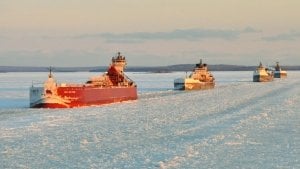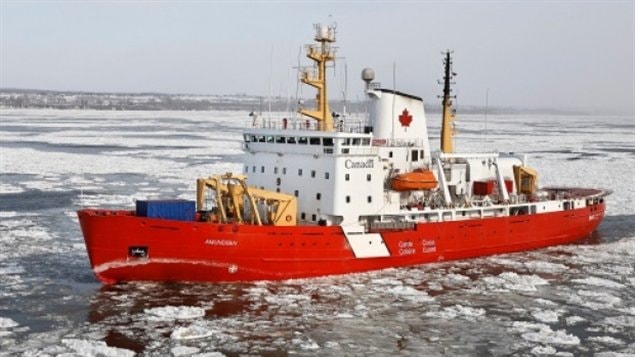Even as Canada’s eastern maritime provinces and Newfounland dig out from a massive storm, the cold has caused problems for shipping in Ontario.

Last night, a spring blizzard swept through east coast Canada dumping up to 50 cm of snow followed by hurricane-like winds of up to 150km and more in some areas.
The long and bitterly cold winter has also meant the Great Lakes are almost entirely frozen over, something that hasn’t happened since Environment Canada began recording statistics in 1972.
Geoff Coulson, a warning preparedness meteorologist at Environment Canada sais that as an example 88 percent of Lake Erie is covered in ice compared to the typical 30-35 percent at this time of year.
The Ministry of Fisheries and Oceans said icy conditions are having a negative effect on the economy since ships can’t pass through the lakes and the St Lawrence Seaway
Typically some $35 Billion in shipping passes through the Seaway each year.
The Canadian Shipbuilders Association said Tuesday that due to the ice, and a lack of icebreakers to clear paths, important shipments of Prairie grain and other goods including iron ore, construction materials and petroleum products from ports such as Thunder Bay, Ontario, would be delayed.
As a result, the government is re-assigning two additional Coast Guard ice breaker to the waterways. Usually there are two.

The additional icebreaker is to be in the Seaway by Friday with another icebreaker and hovercraft to arrive next week, possibly followed by others.
The shipbuilders association says it expects normal shipping might be achieved only by mid April. It adds the Coast Guard doesn’t have enough ships, and they’re getting old.
The Coast Guard admits some vessels are nearing 30 years of age but says they have enough icebreakers for normal conditions, this year is exceptional.
In Thunder Bay meanwhile, the harbor master, Guy Jarvis, says some icebreaking will begin today thanks to two icebreakers from the US.
He says the 42-meter-long Katmai Bay and Morro Bay will open some “tracks” in the harbour. He estimates the first cargo vessel will reach Thunder Bay in the first week of April, a week behind schedule.







For reasons beyond our control, and for an undetermined period of time, our comment section is now closed. However, our social networks remain open to your contributions.